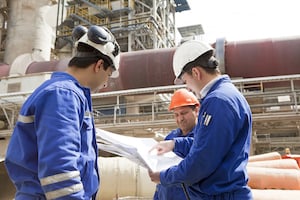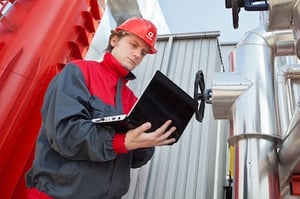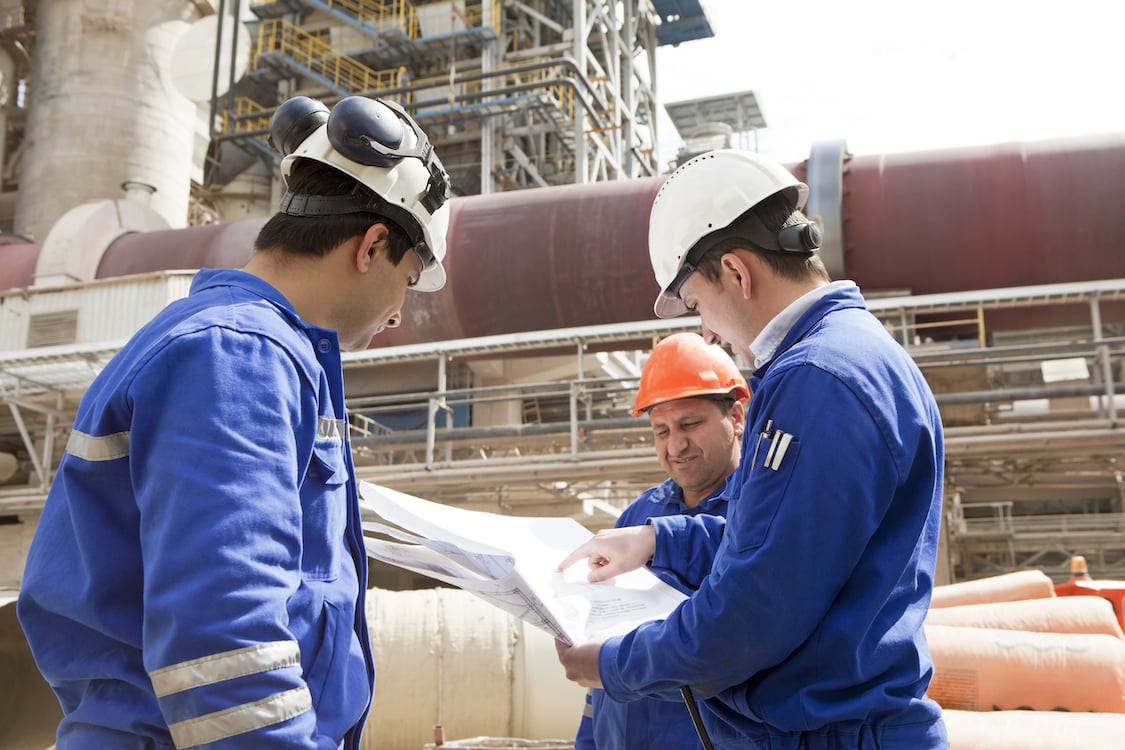This blog post was originally published on November 26, 2019, but it has been updated with current information on June 19, 2023.
If you’ve worked in the oil and gas industry, you’ve probably heard a lot about OSHA regulations, or the term Process Safety Management. This article will touch on just one part of that system, the process hazard analysis, and the facility siting study that it will call for.
The cost of a facility siting study is not an expense that one generally looks forward to. Still, when it could mean the difference between proactively spending money on a study, versus reactively spending money to pay for repairs, lawsuits, or damages, it’s easy to see the clear choice.
RedGuard, for many years a leader in designing blast-resistant buildings, also offers niche engineering services specifically related to explosion resistance in classified areas. We use third party experts including specialists in the energy sector, risk management, as well as structural engineers, and chemical engineers with many years of experience in the analysis of impact and blast response. Our expertise in blast response comes from being pioneers in the industry.
Purpose of a Facility Siting Study
A facility siting study or project siting, is a look at the spacing and placement of both permanent and temporary buildings and equipment in chemical processing plants. Its purpose is to make sure that buildings are located at safe distances in relation to process units. But, it’s about more than just optimal distances.
A facility siting study identifies and documents potential blast, fire, and toxic hazards in a petrochemical facility. It is also a look at threats associated with both permanent and future-occupied buildings.
There are a few end results to consider in regard to a facility siting study. The first is the benefit to onsite employees in having a safer work environment. For the company, once the appropriate measures are taken, it means less liability in the event of any kind of onsite incident.
A facility siting study is consequence-based, meaning it assesses the results of a potential fire, explosion, or toxic chemical release. There are also risk-based studies, which we’ll look at later in this article.
When Should I Get a Facility Siting Study?
To ensure the safety and efficiency of a facility, it is recommended to conduct a facility siting study every five years to assess the potential risks and hazards associated with the facility's location.
A project siting study will usually be initiated during an OSHA Process Hazard Analysis (PHA). The PHA is a more extensive study, completed every five years, that analyzes potential causes and consequences of fires, explosions, releases of toxic or flammable chemicals, and major spills of hazardous chemicals. It focuses on equipment, instrumentation, utilities, human actions, and external factors that might affect processes.
Another time that a facility siting study could be initiated is when new buildings and equipment are added to a refinery. It can be useful so that optimal distances are taken into consideration and to make sure potential safety concerns are identified when the building or equipment is added. Ultimately, it is always best to move occupants to a safe area, if possible, but most of the time, this isn't an option.
Another initiating factor would be a change to the processes that are performed onsite. In many instances, petrochemical facilities don’t have the luxury of real estate, so existing buildings can be retrofitted to mitigate the potential threats, as opposed to just moving the buildings to a safe area. In these ways, a facility siting study is seen as a continuous cycle.
Are there options other than a Facility Siting Study?
During the PHA, a facility may choose to do a quantitative risk analysis, or QRA, instead of a facility siting study.
A QRA is a risk-based study that quantifies your highest priority risks. This study will typically contain all of the information you would find in a project siting study but is a more comprehensive, advanced analysis. The QRA can also be used to fulfill the OSHA requirement that comes up every five years in the Process Hazard Analysis.
A facility siting study, which is less costly and quicker to perform, is based on Maximum Credible Events (MCEs) and is a more conservative study. This means the results tend to be conservative, and that could impact the cost of modifying existing occupied buildings or adding future-occupied buildings.
The extra element that QRAs have that facility siting studies don't is statistical probability. The statistical probability helps remove some of the conservatism and allows companies to make decisions based on their risk tolerance. While facility siting studies and QRAs both serve a purpose, most larger companies and facilities will benefit from the risk-based study, the QRA.
What Should you NOT do?
One thing that is not an option is skipping an analysis altogether. Not having the PHA, and in turn, not doing a facility siting study, is a serious risk. Not only could a facility risk a fine from OSHA when their infraction is discovered, there could also be more catastrophic consequences.
A facility that fails to do a PHA is at risk of missing a serious hazard. A hazard could cause a major accident, which at the very least, risks damage to expensive property and equipment, and at worst, could result in many deaths, injuries, and have negative environmental consequences to the surrounding community.
The actual financial cost to the facility for damaged equipment, materials, or buildings would pale in comparison to the financial consequences once the dust settles and the victims or their families take legal actions. It is not unheard of for the final cost of a refinery blast event, taking legal settlements into account, to come to a billion dollars.
Who performs the Facility Siting Study?
During a site walk, typically, two or three representatives from the firm performing the site study will come onsite. This is dependent upon the size of the facility, and types of processes. These representatives will consist of a Process Safety Expert or Engineer, a Structural Expert or Engineer, and potentially, a technician to help measure and document buildings and processes.
A Process Safety Engineer will be the one to actually study the documentation supplied by the facility’s personnel to identify and calculate the hazards. They are the ones that create the hazard contour diagrams for blast, fire, and toxic chemical releases.
A Structural Engineer, specializing in blast and hazardous engineering, will also be involved. They use the results generated by the Process Safety Engineer to help identify occupied buildings that will need to be addressed to mitigate the potential site hazards.
When searching for a vendor to conduct your facility siting study, it's crucial to inquire about their qualifications. Although there is no certification for their expertise, it's common to ask about their years of experience in structural analysis. More importantly, ensure that the representatives are unbiased third-party experts. This means that once they identify potential hazards and suggest solutions, their recommendations will not be influenced by their personal interests, like their employer or parent company. This ensures an unbiased evaluation of the risks and hazards present in your facility.
What personnel need to be onsite for a Facility Siting Study?
Facility Siting Studies are conducted during normal plant operations with minimal to no  disruption of personnel. Ahead of the site visit, there will likely be a request for data from the company performing the analysis. This information is detailed below.
disruption of personnel. Ahead of the site visit, there will likely be a request for data from the company performing the analysis. This information is detailed below.
Typically, it is best to have one or two site personnel to serve as escorts and to answer questions about processes, as needed. This will usually be a Health, Safety, and Environmental (HSE) representative and someone from the operations side of the business.
This is helpful because sometimes information on process flow diagrams (PFD) or piping and instrument diagrams (P&ID) is out of date. The site personnel can help fill in missing information or provide an overview of the process change.
What are the parts of a Facility Siting Study?
1. Preparation for Facility Siting Study
The company doing the facility siting study will communicate with you ahead of time to prepare for the facility site walk and tell you what to expect. They will also talk to you about information they need before they can begin. Be prepared to give them customer/site information, like process flow diagrams, piping and instrument diagrams, site plans, process descriptions, and emergency response procedures.
The information gathered during preparation is used ahead of the next step, which is a site walk, to help the engineering team understand the plant operations. There will be a quick analysis of the information to identify areas to target while onsite and to see if there is any information missing.
During this preparation stage, they may ask about PPE. They will need to know if there is any required or recommended PPE outside of hard hats, steel-toed shoes, fire-resistant clothing, and safety glasses. If so, will it be provided onsite, or is it best for them to bring it with them?
Communication is key during preparation. While they are telling you what to expect on the site walk, they should also disclose what tools will be used, and what measurements will be taken.
As an example, they may tell you that they will be marking paper drawings, taking photographs, taking measurements, and making notes. They should even go as far as telling you the tools they will use, such as a flashlight for dark areas, handheld laser range finder, and tape measure. While these things seem basic, there should be no surprises. Knowing the details of what they will bring on-site allows you to disclose information about known limitations.
One example of a known limitation is digital cameras. Though they are battery-operated, low-power, and low-signature, they can still be considered not intrinsically safe. Be sure to disclose which areas do not allow flash photography or if you require the use of your own camera or photographer. Your site may have other known limitations, and the preparation stage is the time to talk about them.
2. Facility Site Walk
The Facility Site Walk is the scheduled day that structural and blast experts will come onto your site. They will be there to physically observe and document your plant processes, hazards, and occupied structures.
They will make additional notes, take measurements and photographs. Typically, inspections will be inside and outside of the unit. Usually, access to elevated areas will be via normal walkways and stairways.
It’s a good idea to keep in mind that there could be exceptions to either of the above. For example, if specialty chemical or other protection is required, they will likely need to gather information from outside the unit. And there’s always a possibility that there could be a special need to access an elevated area through means other than walkways or stairs.
During the site walk, they will draw on the knowledge of your onsite representative with knowledge of the plant’s processes or operations. The company performing the study will postulate preliminary hazards and ask questions concerning safety systems, process controls, material composition, and process equipment/conditions. Scenarios and relevant data will be captured in a spreadsheet.
The information gathered in this stage will be used during the actual analysis for model and calculations inputs. The duration of the site walk is dependent on the quality of data received during preparation, and the complexity of the site.
3. Analysis and Results
Following site visit activities, all of the data will be reviewed. The vendor will analyze pictures and notes from the site walk, perform analysis and calculations to map hazards, provide a draft report you for review, and, most importantly, prepare the final report for your use. How long it takes to get the final report is dependent on what is found and the complexity of the site and its processes.
The type of report you receive from your vendor after the site walk can vary from company to company. It’s important to ask ahead of time what they provide.
Getting Facility Siting Study Results: Buyer Beware
You should be aware that some companies will only perform the facility siting study, identify the hazards, and create contour maps. They don't include any information on occupied buildings or mitigation options and may simply hand you a report.
It’s a good idea to be sure ahead of time that the results from your facility siting study will identify buildings with issues so that you can prioritize how to mitigate risks.
On the other hand, another thing to watch for is the relationship between the engineering firm and the solutions they recommend. The engineering firm should be third party, with no vested interested in selling solutions. If the one and only solution identified happens to be sold by the engineering firm, or a branch of their company, that's a red flag. There are engineering firms who can offer free or low-cost second opinions when this is the case.
What happens when a Facility Siting Study finds problems?
When issues are found, they should be documented and included in the report. A good facility siting study also includes a section on mitigating risks. At this stage, the mitigation plan may not be thorough, but it will be a starting point to taking action.
Typically, a follow-up project to do a more detailed conceptual mitigation analysis for these areas should be scheduled.
What are the most common issues uncovered in a Facility Siting Study?
There is a wide range of issues that could be uncovered. It all depends on the age of the facility, the number of occupied buildings onsite, and whether this is the facility's first site study or if they've done a few of them in the past.
However, it is common to find at least a handful of occupied buildings that could have structural issues in the event of a blast.
There are many types of issues that can be found. But here are just a few examples:
- A new process has been added and existing buildings are no longer strong enough to be occupied buildings.
- A building's walls are not strong enough to withstand a blast, even if other structural elements (like the roof) are.
- A building contains structural elements that are no longer deemed safe. This could be due to changes in a process or layout changes of the refinery. Examples of some structural elements this could affect are canopies over doors or windows, wall openings, or the actual doors or windows themselves.
- A building is starting to show wear and tear due to age.
How long do I have to get problems taken care of?
The most important thing to do is take some sort of action, any action. A facility siting study is completely useless if you just put the report on the shelf.
 It is meant to be used as a guide to prioritize plant improvements. Most of the time, it isn't feasible to address every issue identified in the study immediately. There could be budget constraints, time constraints, and constraints due to business interruptions.
It is meant to be used as a guide to prioritize plant improvements. Most of the time, it isn't feasible to address every issue identified in the study immediately. There could be budget constraints, time constraints, and constraints due to business interruptions.
However, if you can demonstrate that you are taking action, and are at least doing something (i.e., have a targeted plan to address one or two building improvements per year), this will go a long way if OSHA ever audits your facility.
Having a vendor that you trust and feel open to asking questions about your facility siting study is imperative. You should feel encouraged to take action and lean on them for questions.
The firm you choose should help facility personnel walk through your mitigation plan. They should be motivated to help you keep your team safe, and that can only be done by making changes.
How do I get a facility siting study?
Begin by researching the companies that provide engineering services that include facility siting studies. There are a lot of companies that provide a broad range of engineering services, with facility siting studies being just one of those services. Consider using a company with experience and expertise in blast analysis and hazard mitigation.
While a company that offers many different kinds of engineering services may be completely fine for some uses, they may not have the experience in process safety management or even risk management that you need to get you through this process. In fact, some firms may be using staff that have nothing more than a crash course in blast hazards under their belt. Always look for a company that will bring degreed professionals on-site and who have many years of experience in risk assessment, safety, or experience with explosions.
Price should never be the only factor in finding a company to perform your facility siting study. Because it is a critical component to safety and compliance, be sure to hire a company that delivers according to your needs. This means finding a combination of service, experience, and value that you are comfortable with.
If a facility siting study is your next step, there are some preliminary things to start thinking about. Luckily, we’ve got a handy checklist for that.
Phillip Lange
Phillip Lange is the technical sales manager at RedGuard. With his experience working with companies in the oil and energy industry, his specialties include process scheduling, negotiation, budgeting, value engineering, and operations management. He oversees technical engineering services that are offered at RedGuard, like facility siting studies, building retrofits and custom blast-resistant solutions.





